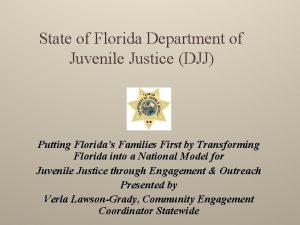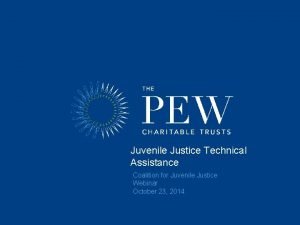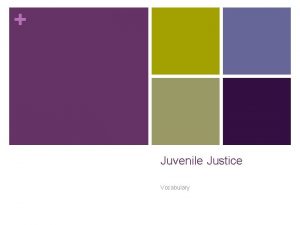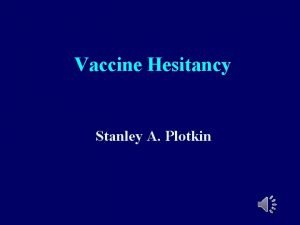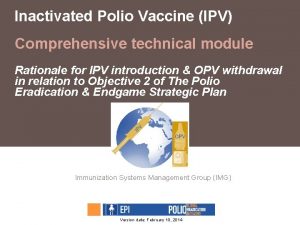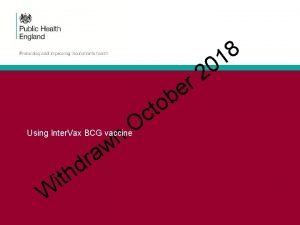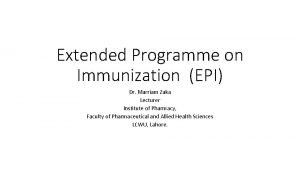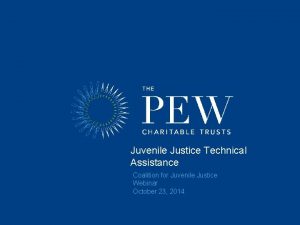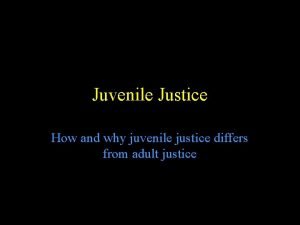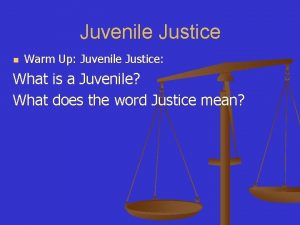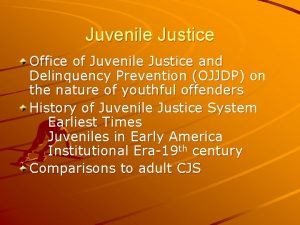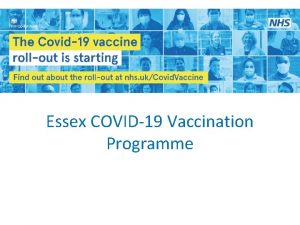Catherine A Gallagher Adolescent Vaccination in Juvenile Justice



















- Slides: 19

Catherine A Gallagher Adolescent Vaccination in Juvenile Justice Residential Facilities

Adolescents involved in the Juvenile Justice System Probation (daily) Facility population (daily) Formal Informal Total 392, 651 96, 264 488, 915 108, 465 Daily population on probation or in confinement: 597, 380

Yearly admissions to Juvenile Justice Residential Facilities Gatekeeper facilities 1, 228, 720 Detention 1, 166, 141 Shelters 62, 579 Second-step Facilities 721, 109 long-term Secure 87, 978 group Home 68, 309 RTC 146, 789 multi-type 277, 029 reception 70, 478 Camps 62, 118 Other 8, 407 Total 1, 949, 829

Underserved and high-risk Missed preventive and ongoing care in the community • 66. 4% without regular source of medical care • 25. 5% couldn’t remember the last time they received medical care Every risk factor for missed vaccines • Interrupted health coverage • Use of multiple health care sites (record-keeping) • Lower SES Disproportionately exposed to risk through risk-related behaviors • Higher involvement in injection drug use • Unprotected sex with multiple partners and at earlier ages Close-quarter living of Juvenile Justice Residential Facilities

The importance of this population to national leadership Every national professional organization CDC OJJDP Office of the Surgeon General

Joint-agency Partnerships Example 1: Joint effort between OJJDP, CDC, GMU to address Hepatitis B vaccination in JJRFs New series on Hepatitis B pre-tested and added to the 2004 Juvenile Residential Facility Census

Results of JRFC 2004 Hepatitis B data collection Alarmingly low levels of availability and provision Systematic patterns of provision across multiple outcomes • Any young people receive Hepatitis B vaccine • Who receives vaccine • Any doses given in reference period

Multinomial logit models suggest higher odds of provision in facilities that: Are longer stay State-owned facilities Have on-site education Provide physical health exams Are larger Are in states with laws requiring Middle. Schoolers to have Hepatitis B vaccines

Vaccine availability Gate-keeper facilities 1, 228, 720 Detention 1, 166, 141 Shelters 62, 579 Second-step Facilities 721, 109 long-term Secure 87, 978 group Home 68, 309 RTC 146, 789 multi-type 277, 029 reception 70, 478 Camps 62, 118 Other 8, 407 Total 1, 949, 829

Joint-agency Partnerships Example 2 Expansion of vaccine data points for JRFC 2006 and A qualitative study of obstacles to delivery of appropriate vaccines and VFC program participation

Qualitative Study Results on Obstacles to Vaccine Delivery Major Themes from Facility Respondents 1. 2. 3. 4. 5. 6. 7. Vaccines are beyond the scope and purpose Costs Consent HIPPA Passing the buck to the school Immunization records Never heard of VFC

Qualitative results similar to JRFC hepatitis B findings Short stay, pre-adjudicated, local and private facilities most likely to state obstacles Issues involved • High turnover • Short length of stay • Coordination with parents and local providers • Security • Legal proceedings • LEGAL STATUS/CONSENT

Highly variable length of stay across facility types

Percent new admissions on reference day by facility type

Issues involved Custody/Consent • Differences in legal and physical custody • Unwillingness to provide consent even in legal custody • Lack of understanding on state laws for consent for vaccines (note STD issues) • Bailiwick of the schools • In many cases of physical custody status, consent may already be waived to facility/agency • Difficulty in understanding what actors are capable of providing consent (e. g. , probation officers, social workers from other state agencies, facility administrators) • WITHIN DETENTION CENTERS THERE A VARIETY OF COMPLEX CUSTODY STATUSES

Next steps in research: New national data points on vaccine payment and consent (JRFC 2006)


Nest steps for research for JJSinvolved adolescents Establish relative-risk of under-immunization Estimate timing of infection/exposures and rates of transmission of vaccine-preventable diseases Model impact of full vaccine coverage for facilities, communities and adult correctional populations Determine whethere is a role for community supervision (probation)

Next steps for addressing obstacles Time Assist facilities by providing self-report-based (record-free) algorithm for vaccine decision-making Costs/Infrastructure Further develop partnerships between state-level VFC coordinators, local short stay facilities and local health agencies Consent Explore mechanisms for addressing consent issues (judicial involvement) Law Research the role of state law and education requirements on facility vaccine provision Educate Private facilities on the importance of vaccine provision
 Juvenile justice act 2000
Juvenile justice act 2000 Race matters for juvenile justice
Race matters for juvenile justice Minnesota juvenile justice system
Minnesota juvenile justice system State of florida department of juvenile justice
State of florida department of juvenile justice North carolina juvenile justice
North carolina juvenile justice Chapter 11 basic concepts street law
Chapter 11 basic concepts street law Juvenile justice alternative education program
Juvenile justice alternative education program Juvenile justice system in georgia
Juvenile justice system in georgia Republic act 9344 juvenile justice and welfare act of 2006
Republic act 9344 juvenile justice and welfare act of 2006 Juvenile justice system georgia
Juvenile justice system georgia Coalition for juvenile justice
Coalition for juvenile justice Juvenile delinquency vocabulary words
Juvenile delinquency vocabulary words Mandatory vaccination
Mandatory vaccination Dog vaccination perry county
Dog vaccination perry county Opv vs ipv
Opv vs ipv Mark anthony fernandez vaccination
Mark anthony fernandez vaccination Vaccine vial monitors
Vaccine vial monitors Conclusion of immunization
Conclusion of immunization Poultry vaccination schedule
Poultry vaccination schedule Defaulter vaccination schedule
Defaulter vaccination schedule



